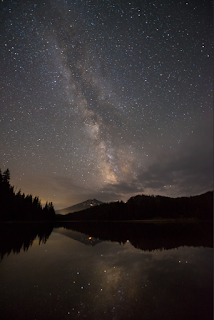And when I finally arrived, I wasn't disappointed: it was beautiful and amazing. We first stopped at the Watchman parking lot and climbed up to the Watchman spot to take images of the sunset. Because of the wildfires, the sunset was nothing short of spectacular. Though it was more beautiful in the valley around crater lake then in the lake itself. Here are just X images - I took so many and it was very difficult to choose.
After that, we moved to a different location on the east rim to take Milky Way shots. With some trees and the lake, there were a lot of options to compose the image. Here are my two best shots:
I also took a Milky Way panorama with our group below (Brian light painted them):
Finally, we moved to a spot on the north rim to sleep (in the cars) where I setup my slider to take a sunrise timelapse of the Milky Way and the lake:
Yes - just before sunset (you can see the first glimpses of light coming into the picture) the batteries of my camera ran out ...
Continue on 4th night: Crater Lake take two




































